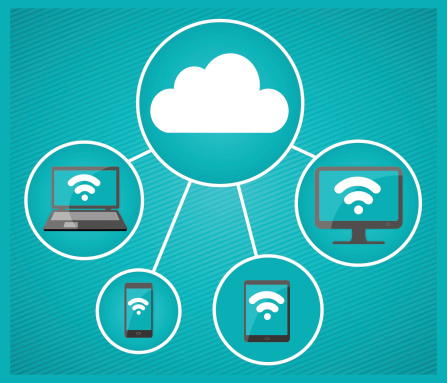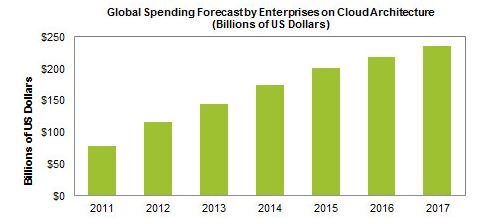Business cloud related spending, i.e. companies moving their IT services, infrastructure and applications to a cloud-based architecture, will have tripled by the end of 2017 compared to 2011, says a new report published by IHS Technology.
The new report is titled “Cloud & Big Data Report – A Paradigm Shift in the ICT Industry – 2013“.
Cloud related spending by businesses on infrastructure and services is expected to reach $174.2 billion this year, twenty percent higher than $145.2 billion in 2013.
As companies compete for their own cloud-storage solutions, cloud related spending is expected to continue growing strongly during the next few years.
Report author Jagdish Rebello, Ph.D., senior director and principal analyst for the cloud and big data at IHS, estimates that by 2017 business cloud related spending will have reached $235.1 billion, more than three times 2011’s figure of $78.2 billion.
Rebello said:
“With the cloud touching nearly every consumer and enterprise around the globe, spending for cloud-related storage, servers, applications and content will be dedicated toward building a framework that is rapidly scalable, highly dynamic, available on-demand and requiring minimal management.”
“The robust growth will come as an increasing number of large and small enterprises move more of their applications to the cloud, while also looking at data analytics to drive new insights into consumer behavior.”
Company spending on cloud services will account for a progressively larger portion of total IT expenditure. Businesses currently spend about $2 trillion each year globally on IT.
(Source: IHS Technology, February 2014)
Why is the Cloud becoming more popular?
For companies that provide online storage, analytics, computing and provisioning services, the Cloud is becoming a crucial cornerstone. This is because smartphones and tablets especially, but also computers consume a growing amount of media, and require ever-greater storage solutions, which the cloud can now provide.
This growing market is attracting multibillion-dollar investments in cloud-based architectures, Rebello added.
Companies of all sizes are currently competing to provide enterprises and consumers with their own private or public cloud storage services.
The giants – Microsoft, Apple, Amazon and Google are offering public cloud storage that drives companies’ hardware and content.
The smaller players – Barracuda, Dropbox and Carbonite, in order to compete with the giants, have adopted the Freemium model, in which there is a fixed amount of free storage and a premium storage service customers pay for.
Competitors are fiercely positioning themselves for dominance, Rebello explained. There were 630 million consumer subscriptions to the Cloud in 2013, this year IHS predicts the number will rise to 730 million. This is a huge pool of customers to which cloud-suppliers can market their services, as well as other non-cloud products.
IHS gives as an example Amazon, which has a virtually limitless number of products. If Amazon manages to turn a casual user of its online Cloud services into a loyal and permanent client, the business opportunities are endless.
Wireless providers well placed to offer Cloud services
Among the competitors offering services and infrastructure, wireless providers are in an especially strong position to offer online Cloud storage to boost value to their consumers.
The Cloud can help reduce churn, a periodic problem experienced by all wireless providers as customers move to other operators. By seeking out demographic data using the Cloud, providers can also put forward individually-targeted offerings for their existing clients.
“By using big data and sophisticated data-analytic tools, wireless providers could offer truly differentiated services to subscribers,” Rebello explained.
So far, however, wireless operators still lag a long way behind the likes of Google or Amazon regarding cloud offerings. They are missing out on an enormous cloud-related earning potential “which is going instead to rival faction of the mobile value chain.”
IHS believes:
“All told, cloud services must strike the correct balance between providing convenience to users, while at the same time respecting their privacy.”
What is the Cloud or cloud computing?
We all used to keep our data, i.e. music, files, movies and photos in vinyl records (LPs or EPs), video cartridges, photo albums made of paper, and paper files.
As technology evolved these data were stored on a floppy disk, CD or computer hard drive.
Many pictures today are stored online on Facebook or Flickr, we listen to music on Pandora or some similar service, and watch TV programs and movies on Amazon or Netflix.
In all three cases, the pictures, music and movies are not stored in our computers, but elsewhere – that place is known as The Cloud.
Put simply, the Cloud refers to the Internet, regarding things we used to store on our computers, CDs, sticks or floppy disks.
If somebody tells you they stored something “in the Cloud”, they mean it was stored online on an Internet service. Webmail or email services are in the Cloud.
Cloud services offer software, hardware and information resources.
Who coined the term “Cloud computing”? – According to an article written by Antonio Regalado in the journal MIT Technology Review, the term was born in 1996 at an office park outside Houston, Texas.


